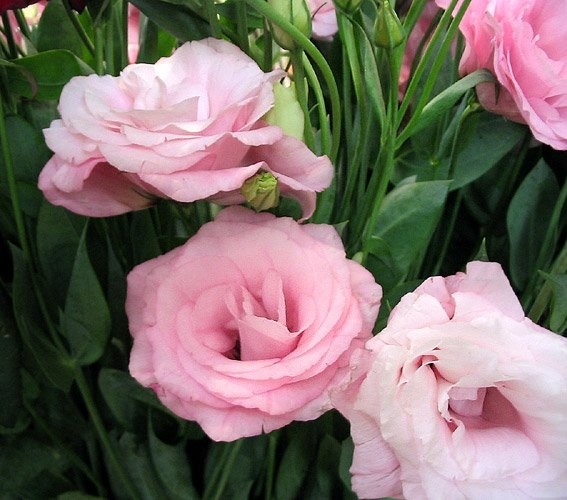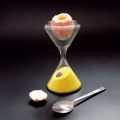You know, it can be very difficult for me to explainto male acquaintances and some girlfriends, what flowers I like. The only way out is to write a guide, not to give everyone a tour of flower shops? So I'll start with my favorite. Eustoma - with a medical name. It looks like this: The subject of conversation is lisianthus, akaeustomaPrairie gentian, lisianthus, Texas bluebell, Tulip gentian, bluebells, lira de san pedro - these are all Eustoma, a relative of the gentian. In our flower stalls it responds to eustoma and lisianthus. The second name is more commercial - it sounds too medical - "eustoma" (it turns out either "delicious" or "magnificent", if you are sophisticated in interpreting the Greek roots). The plant was described in the 19th century by botanist Thomas Drummond, calling what he found in Texas Lisianthus russellianus. In the wild, the flower grows in the lowlands and on the banks of rivers in Arizona, Colorado and northern Mexico. Wild eustoma is a rather boring plant: squat, with flowers of different shades from blue to purple. In 1835, the flower ended up in the Glasgow Botanical Garden, and then began to spread to pots on the windowsills. One way or another, its description as a houseplant appeared in 1878. The flower gained immense popularity in Japan under the name Torukokikyo (Toruko - lady's hat and Kikyo - bellflower, to be more precise, Platycodon). In the late 60s of the 20th century, it was discovered that there are white and pink eustomas. Since then, things have gone - double and large-flowered varieties have appeared, red, light yellow, two-colored flowers have appeared. The flower turned out to be convenient for transportation, spectacular in bouquets and long-lived in vases, and there were also fans of growing it in pots. They write that it is usually impossible to buy eustoma seeds, since they are only available to commercial flower farms. Theoretically, 15 thousand plants can be grown from one gram of seeds. The development process before the flowering phase of modern varieties lasts about three months. Seedlings are kept at a high temperature and with additional artificial lighting. The technology of cultivating eustomas has now been developed to the smallest detail; flowering plants can be obtained at any time of the year. In order for the cultivation mode of these heat-loving flowers to be as economical as possible, they should be purchased in July. Then they will bloom throughout the second half of the summer, requiring virtually no costs. They can be placed outdoors, planted in flower beds or containers. Low-growing forms of eustoma are grown as indoor plants.
The subject of conversation is lisianthus, akaeustomaPrairie gentian, lisianthus, Texas bluebell, Tulip gentian, bluebells, lira de san pedro - these are all Eustoma, a relative of the gentian. In our flower stalls it responds to eustoma and lisianthus. The second name is more commercial - it sounds too medical - "eustoma" (it turns out either "delicious" or "magnificent", if you are sophisticated in interpreting the Greek roots). The plant was described in the 19th century by botanist Thomas Drummond, calling what he found in Texas Lisianthus russellianus. In the wild, the flower grows in the lowlands and on the banks of rivers in Arizona, Colorado and northern Mexico. Wild eustoma is a rather boring plant: squat, with flowers of different shades from blue to purple. In 1835, the flower ended up in the Glasgow Botanical Garden, and then began to spread to pots on the windowsills. One way or another, its description as a houseplant appeared in 1878. The flower gained immense popularity in Japan under the name Torukokikyo (Toruko - lady's hat and Kikyo - bellflower, to be more precise, Platycodon). In the late 60s of the 20th century, it was discovered that there are white and pink eustomas. Since then, things have gone - double and large-flowered varieties have appeared, red, light yellow, two-colored flowers have appeared. The flower turned out to be convenient for transportation, spectacular in bouquets and long-lived in vases, and there were also fans of growing it in pots. They write that it is usually impossible to buy eustoma seeds, since they are only available to commercial flower farms. Theoretically, 15 thousand plants can be grown from one gram of seeds. The development process before the flowering phase of modern varieties lasts about three months. Seedlings are kept at a high temperature and with additional artificial lighting. The technology of cultivating eustomas has now been developed to the smallest detail; flowering plants can be obtained at any time of the year. In order for the cultivation mode of these heat-loving flowers to be as economical as possible, they should be purchased in July. Then they will bloom throughout the second half of the summer, requiring virtually no costs. They can be placed outdoors, planted in flower beds or containers. Low-growing forms of eustoma are grown as indoor plants.

Making Money with Desserts: Success Stories
Evgeniya Polischuk (Fedutinova) instagram:@evgeniyafedutinovavk.com/janeshomebaking– It all started with baking for family and friends. Gradually, I started posting photos of my baked goods on Instagram – and orders started coming in. I made my first custom-made cake on October 13, 2014, and a little earlier I started making macaroons and cupcakes. You could say that the business “found me”, I am very […]

Soups are cold recipes with photos
Cold cucumber soup with yogurt and lemonsorbet from the chef of the restaurant La Taverna Alexander Zhurkin Photo: Getty Images Ingredients: Plain yoghurt – 125 g Cucumber – 150 g Lemon/lime sorbet – 50 g Cocktail shrimp – 24 g Fresh ginger juice – 1 g Lime juice – 5 g Fresh orange juice – 5 g Parsley – 1 g Pink pepper – 1 g Watercress – […]

barbeque kebab
Pork tenderloin in glaze Photo:Dmitry Bayrak/dbstudioPreparation time: 20 minutes + marinating time.Calories: 454 kcal per serving.For 4 servings: 4 pork tenderloins (approximately 300 g each), 1 onion, 2 cloves of garlic, 1 tsp. lemon zest, 1 tsp. lemon juice, a pinch of ground cumin, coriander and turmeric, 1 tbsp. vegetable […]

Pierre Duacan: dietary recipes: Ducane diet
Beetroot soup Photo:Season’S, Luxury Hotels RepresentationYou will need:· Boiled beetroot – 60 g· Fresh cucumbers – 20 g· Red radish – 20 g· Green onions – 10 g· Egg – 1 pc.· Drinking mineral water – 200 g· Salt – 1 gPreparation:· Boil the egg and beetroot.· Grate the cucumbers, radish and part of the beetroot. Put everything […]





